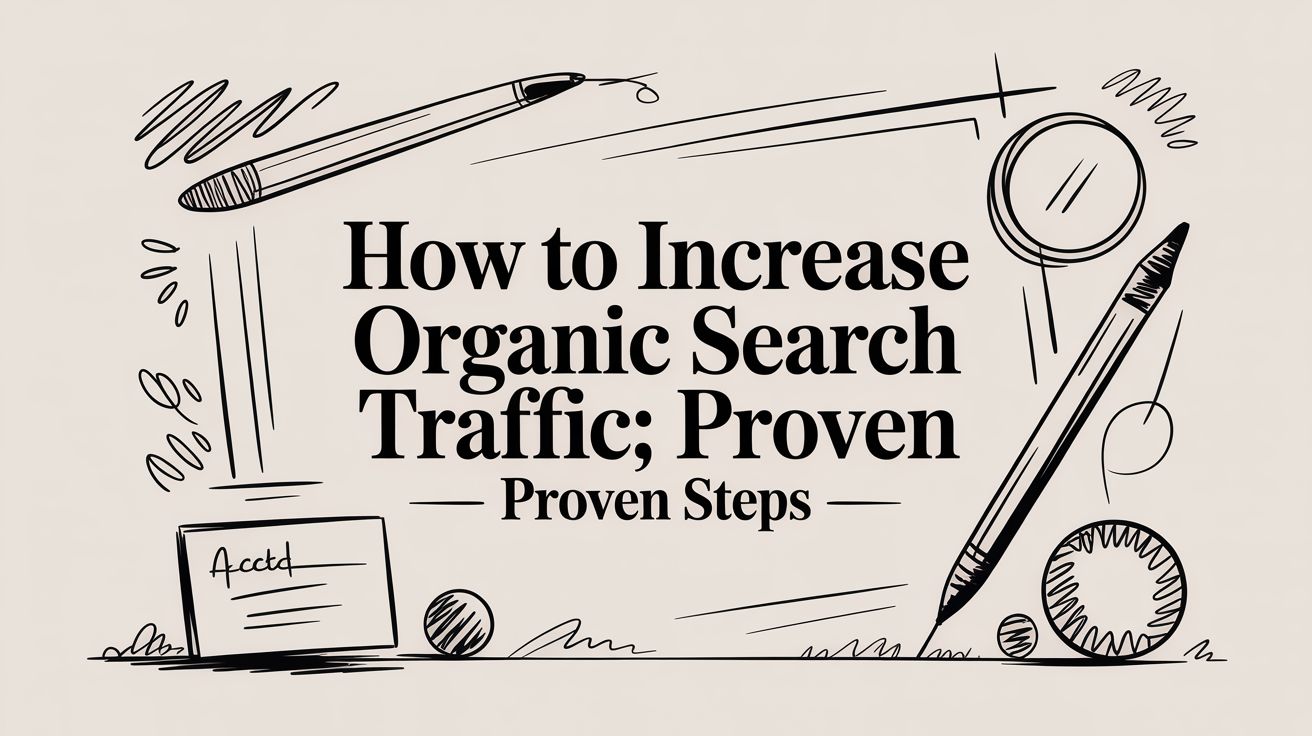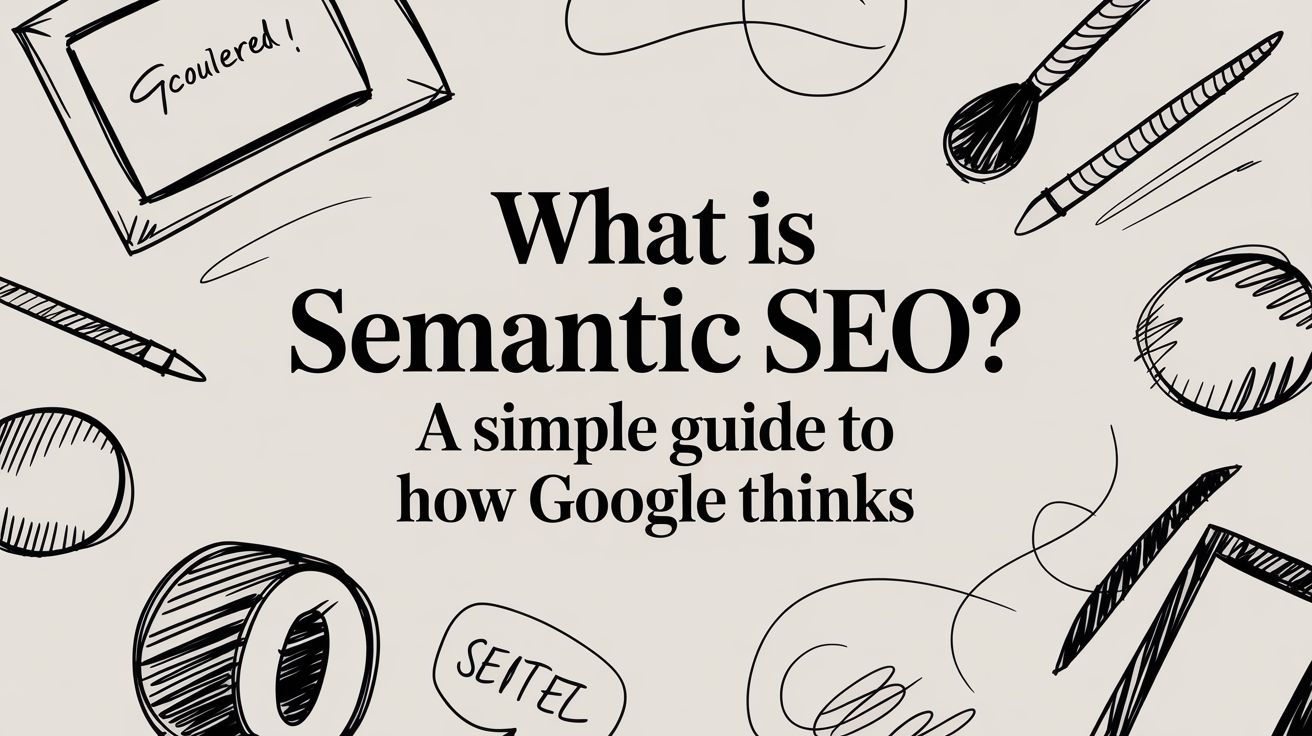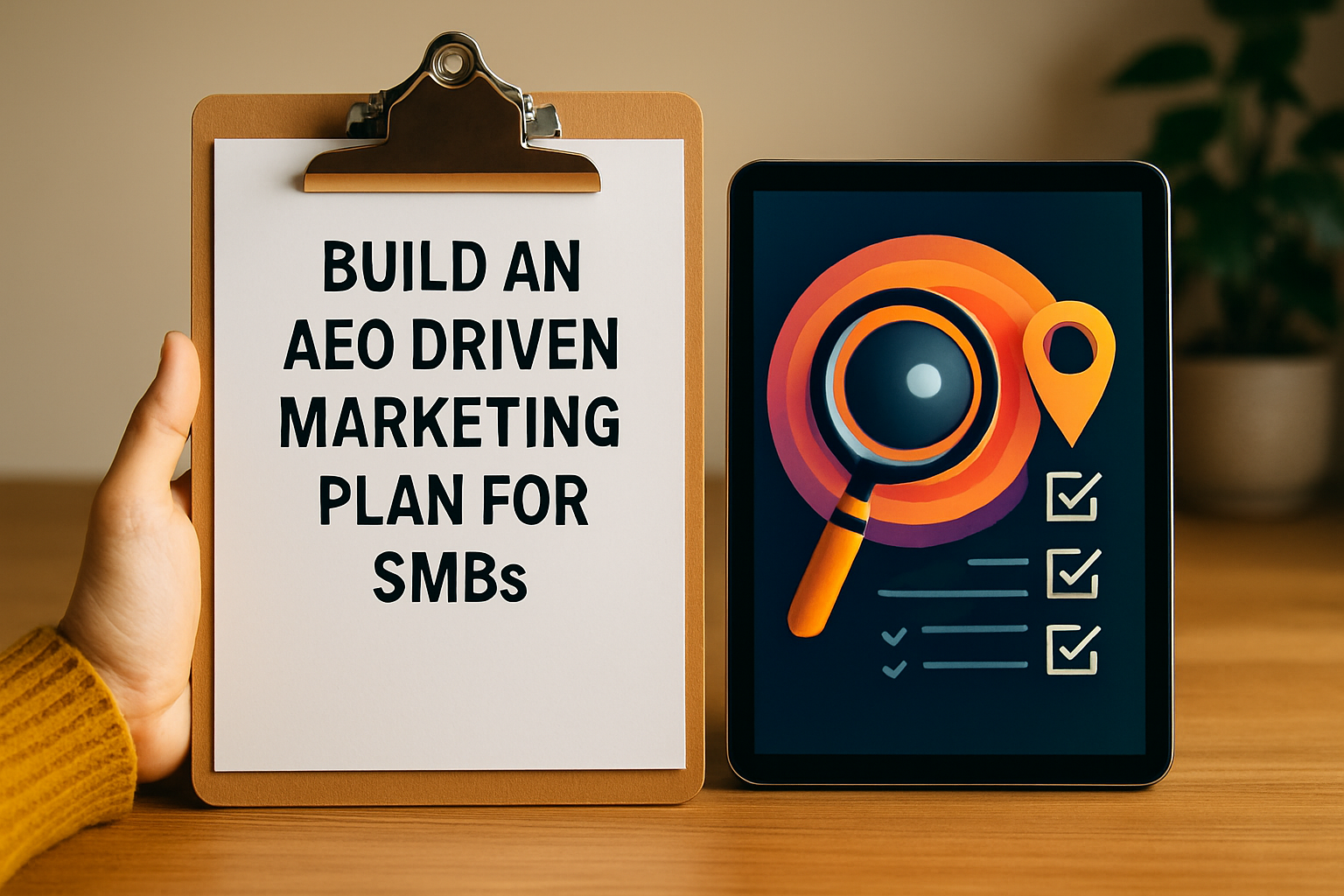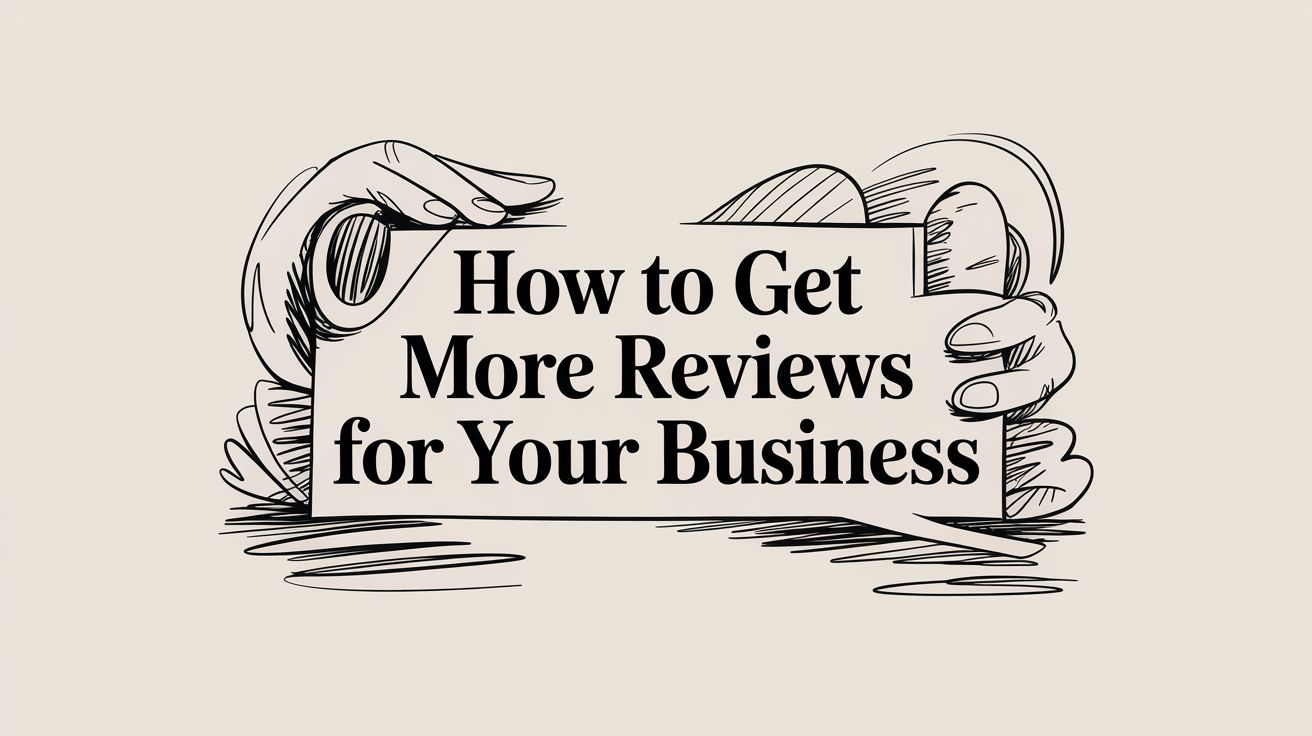How to Get More Visitors From Google, Step-by-Step

Do you want more people to find your website on Google? It all starts with one super simple idea: know where you're starting from.
Before you try to get more visitors, you need to take a good, honest look at how your website is doing right now. Don't worry, this is way easier than it sounds.
Find Your Starting Line in the SEO Race
Getting more people to find you on Google can feel like a big, tricky puzzle. But the very first piece is just looking at what you've already got. This isn’t about scary numbers or confusing charts. Nope. It's about being a detective for a few minutes to see what’s already working. Cool, right?
Think of your website like a tiny shop. Before you order a bunch of new stuff to sell, you'd check which things are already popular, wouldn't you? You’d want to know who is coming into your shop and what they like the most. That’s exactly what we’re going to do, but for your website.
Get to Know Your Visitors
The first thing to do is just understand who is visiting your site and how they found you. You don’t need fancy, expensive tools for this. Google gives you two awesome—and totally free—tools that tell you everything you need to know.
- Google Analytics: Think of this as the friendly person at your shop's door. It tells you how many people came by, which pages they liked the most, and how long they stayed. It gives you a good look at how your website is doing overall. You can get Google Analytics here.
- Google Search Console: This tool is your secret superpower. It tells you the exact words people typed into Google right before they found your website. This is like finding treasure because it shows you what your visitors are really thinking about. You can get Google Search Console here.
Looking at this stuff isn’t a test you can fail. It's just a friendly check-up. Maybe you’ll find a blog post you wrote a year ago is suddenly bringing in lots of new people every week. Wow! Or maybe you'll see everyone is looking for something you offer but hardly ever talk about.
The goal here is just to see things clearly. You're just gathering clues to make a better plan. Understanding who is visiting you now is the most important step before you change anything.
Why This Simple Step Matters So Much
Jumping into action without knowing this stuff is like trying to drive to a new city without a map—or even knowing where you are right now. You’d just be guessing.
But when you know which pages are your superstars and which words are your secret doorways, you can make really smart choices. You can make more of what people already love and fix the stuff that isn't working so well.
I once helped a small business that found out their most popular page was an old "About Us" story. It wasn't fancy at all, but people loved it. This simple discovery helped them change their plan to focus on telling more stories. It worked! Their traffic went way up because it felt real and people liked it.
By taking a moment to look at your visitors, you get a perfect place to start growing.
Make Your Website a Place Google Loves to Visit
Technical SEO. That sounds super scary, doesn't it? Like something only computer experts who speak in code can do. But it's really just about making your website easy for everyone to use—and that includes Google, which is trying to understand what your site is all about.
Think of your website as a house and Google as a visitor. If the path to your door is clear and the door opens easily, they’ll happily come inside and look around. But if the path is full of weeds and the door is stuck, they’ll probably just turn around and leave.
That's all technical SEO is: making sure your website "house" is in good shape, so both people and search engines want to stay for a while.
Is Your Website Fast or Frustrating?
We’ve all been there. You click on something, and then you just… wait. And wait. And wait. Most of us give up after just a few seconds and go back. A slow website is like a locked door for new visitors.
Sometimes, the reason is super simple. A single, giant picture that's too big can make your whole page slow down. It's one of the most common problems I see, and lucky for us, it's one of the easiest to fix.
Every single second matters. If your page takes just one extra second to load, you could lose a bunch of visitors. A fast website keeps people happy and gets a thumbs-up from Google.
Does Your Site Work on a Phone?
Just look around you right now. Someone nearby is probably looking at their phone. We use our phones for everything, and that’s especially true for looking things up online.
Google knows this. In fact, it now looks at the phone version of your website first when deciding how to rank it. This is called mobile-first indexing. If your site is a jumbled mess on a phone—hard to read, or you have to pinch and zoom—you’re not just making visitors mad. You're telling Google that your site isn't very good for people.
This isn't just a fad; it's how the internet works now. A whole lot—like 61% of all visits from search—are going to come from phones soon. You can look at these mobile search trends to see how important a phone-friendly site is.
A Simple and Clear Path for Visitors
Have you ever walked into a store where you couldn't find anything? The aisles were confusing, there were no signs, and you just gave up and left. A website needs a clear map for the same reason.
This is all about making your site make sense. Can someone find your services page from your main page? Is your blog put into clear groups? This is what we call site architecture.
Here’s an easy way to think about it:
- Homepage: This is your front door. It needs to show people where to go next, plain and simple.
- Main Pages (Services, About, Contact): These are the most important rooms in your house. Make them super easy to find.
- Blog Posts or Articles: Think of these as special, detailed rooms. They should be grouped together in ways that make sense (like "Kitchen Tips" or "Bathroom Ideas") so people can find more of what they like.
A website that’s easy to get around doesn't just help your human visitors. It also helps Google's little robot explorers understand what your site is about and how all your pages are connected. A neat and tidy site is a happy site, and happy sites get more love from search engines. This is a big part of learning how to increase organic search traffic.
Create Helpful Content That Answers Real Questions
Your words and pictures are the heart of your website. They're the real reason people visit you. So, how do you make stuff that people actually want to see? The secret to learning how to increase organic search traffic isn't a secret at all—it’s about being the best, most direct answer to your visitor's questions.
Forget all the old tricks, like stuffing your pages with the same word over and over until they sound silly. Today's goal is much easier: write for people first. When you always solve problems and give people real help, Google notices. Your site stops being just another address online and starts becoming a place people trust—and a place that Google loves to show others.
Listen Before You Write
The best ideas for what to write don’t come out of thin air. They come from listening. Every single day, your future customers are online, typing their biggest problems and questions into Google. Your job is to find those questions and answer them better than anyone else.
Where do you find these amazing ideas? They’re everywhere if you know where to look.
- Social Media Groups: Go into Facebook groups or places like Reddit that are about what you do. What problems do you see people talking about again and again?
- Customer Emails: Your own email is a gold mine. What questions do your customers ask you all the time?
- "People Also Ask" on Google: Type something about your business into Google and scroll down. Google literally gives you a list of other questions people are asking. It's awesome!
When you listen, you stop guessing what people want and start making things you know they need. This one little change is what makes some content get ignored and other content get seen by everyone.
People aren't looking for fancy words; they're looking for help. The more your stuff feels like a direct, helpful answer to a real problem, the more people will trust you.
Be the Best Answer, Not Just Any Answer
Once you know the question, your mission is to create the most complete and helpful answer on the whole internet. This isn't about making it long; it's about being really clear and helpful. Think about what a person really needs after they ask their first question.
If someone searches "how to fix a leaky faucet," they don't just want a list of tools. They need step-by-step directions, maybe a short video showing the hard parts, and a warning about common mistakes. Your content should think about these next questions and put everything in one place. That's how you make something that really helps a person.
The prize for being the best answer is huge. Guess what? Searching on Google is still the number one way people find websites. For 2024-2025, about 53% of all visits to websites come from organic search. That’s more than anything else! And even crazier, the very first result on Google gets a giant 28.5% to 39.8% of all the clicks. Getting to the top means becoming the answer people trust most. You can see more about the power of organic search on SEOinc.com.
Simple Content Ideas to Answer Customer Questions
So, what does this look like? It's often simpler than you'd think. Here are some easy ideas for content that answers the kinds of questions your customers are asking.
| Customer Question Type | Your Content Idea | Why It Works |
|---|---|---|
| "How do I...?" | A step-by-step guide with pictures or a short video. | This is great for teaching someone how to do something. It's super easy to read and follow. |
| "What is the best...?" | A comparison post or a guide that reviews different choices. | This helps people decide by showing them the good and bad of each option, which makes them trust you. |
| "What does [word] mean?" | A simple post that explains a word in easy-to-understand language. | You become the go-to person for beginners, getting visitors who are just starting to learn. |
| "Why is... happening?" | An article that explains the reasons for a common problem. | This shows you understand what your visitors are going through and can help them figure it out. |
Making a bunch of helpful, answer-focused content is a great way to grow that lasts. You’re not trying to trick a computer; you're building a library of really useful information that will bring the right people to your website for years and years.
Get Your Content in Front of the Right People
You've worked hard and made something really helpful. That's the toughest part. But even the best content in the world is useless if nobody ever sees it. Think of it this way: you baked an amazing cake, but you forgot to tell anyone you were having a party.
Getting the word out doesn't have to be expensive or complicated. It's about being smart and making sure your awesome work actually reaches the people who need it.
Share Where Your Audience Already Lives
You wouldn’t try to sell winter coats in Florida, right? The same idea works online. Don't just throw your content on every social media site and hope for the best. Go where your ideal customers are already hanging out.
For many businesses that help other businesses—like consultants or software companies—LinkedIn is often the place to be. People are there to think about work and are looking for ideas that can help them solve business problems. A good article shared on LinkedIn can bring in great visitors and make you look like an expert.
- Post Like a Person, Not a Robot: Don't just drop a link and run away. Share a cool quote from your article or ask a question to get people talking.
- Be Consistent, Not Constant: You don't need to post five times a day. Just showing up a few times a week with helpful stuff is what gets you noticed and trusted.
Every time you share, you're not just getting a few clicks. You're also reminding people that you're the person to go to for help in your field.
Build Relationships, Not Just a Link Profile
Another great way to get your content seen is to make friends with other smart people in your area of work. Stop seeing other bloggers or creators as your competition. Think of them as people you can work with.
When you've made something that's truly helpful, don't be shy about letting others know, especially if you mentioned their work in your article. A simple, friendly message can go a long way.
For example, you could send a quick email like this:
"Hey [Name], I'm a huge fan of your work on [topic]. You actually inspired a part of my new article about [your article's topic]. Just wanted to share it with you and say thanks for making such great stuff!"
This isn't about begging for a link. It's about being nice and starting a conversation. When you make these kinds of friendships, people are much more likely to share your work because they know you and trust you.
Each of these shares and links is like a big thumbs-up. It's a signal to Google that your content is good and valuable, which tells it to show your pages to more people who are searching for exactly what you've made.
Build a Website People and Google Actually Trust
There are millions of websites out there. So why should anyone trust yours?
That’s the real question when you want to get more visitors from search engines. Trust is the secret ingredient that wins over both people and Google.
Think of it like getting a recommendation from a friend. You’re way more likely to try a new restaurant if someone you trust says it's great. Online, links from other good websites are like those same powerful recommendations. They’re like little "votes of confidence" telling Google your site is the real deal.
But it’s not just about what other people say. It’s also about how you look. Trust is built on your own website, through simple things that show you’re a real, trustworthy place.
Earning Your Votes of Confidence
When another website links to yours, it’s called a backlink. Backlinks are one of the most important ways Google decides which pages are trustworthy and should be at the top of the search results. The more high-quality "votes" you get, the better your website looks.
Getting these links isn’t about sending spammy emails or using sneaky tricks. It’s about building real friendships and making things that are so helpful, other people just have to talk about them.
- Create something worth sharing: Did you just make an awesome guide or find out something new? That's the kind of stuff that gets links all by itself.
- Be a helpful source: When you share what you know, other writers will want to mention your work as a source.
- Build real connections: Get involved in your community online. When you build a good name for yourself, people are much more likely to share and link to your stuff.
This is about more than just SEO; it's about becoming a respected person in your community. Every single link you get proves that you’re providing something valuable.
A strong backlink profile is like having a great reputation in real life. It takes time and effort, but the trust it builds is super strong and helps you get a lot more visitors from search.
Showing Trust on Your Own Turf
What other people say about you is super important, but what you say and do on your own site matters just as much. We call these on-site trust signals, and they're easy ways to show visitors you're real and can be trusted.
Imagine walking into a store with no signs, no prices, and no employees. You’d probably leave, right? Your website needs to be the total opposite—it should feel clear, professional, and honest from the moment someone gets there.
Here are a few easy ways to build that trust on your own pages:
- Show the people behind the brand: An "About Us" page with real pictures and stories of your team makes your business feel human and friendly.
- Show off real customer reviews: Good words from happy customers show that you do what you promise. A huge 79% of shoppers trust online reviews as much as a friend's recommendation.
- Make it easy to contact you: A clear contact page with a phone number, email, and address (if you have one) shows you're a real business that's not hiding.
These small things add up. They make people feel safe and comfortable, which makes them want to stay on your site and, maybe, do business with you.
Building trust is the key to seeing real, long-lasting growth in your search traffic. It works because it’s all about how people really make decisions. And the reward is huge, because getting visitors from Google is a powerful way to grow a business. It’s expected to bring in almost 44.6% of all money for businesses by 2025. It works because it’s built on trust.
You can learn more about how SEO drives real business growth on Backlinko.com.
Your Simple 30-60-90 Day Traffic Growth Plan
Feeling like this is a lot to take in? That’s totally normal. Seeing the whole plan at once can feel huge, so let's slow down and break it into smaller pieces.
Think of the next three months as a few small, easy-to-handle steps. This isn't a strict rulebook you have to follow perfectly. It's just a simple guide to help you do the right things at the right time. This turns that big, confusing feeling into clear, easy steps. The goal is to get going, not get tired.
The First 30 Days: Foundational Fixes
Your first month is all about getting your house in order. We're not trying to do everything at once; we’re looking for the quick wins that build a strong base for everything else. This is where you’ll see the first changes, which is a great way to feel good and keep going.
Here’s what to focus on:
- Quick Tech Wins: First, make sure your site is fast and works great on a phone. These aren't just nice things to have; they are super important for both your visitors and for Google.
- Know Your Keywords: Open up your Google Search Console and look at what people are already searching for to find you. You don't need to guess. Start making your most important pages even better for these topics.
The goal for month one is to make progress, not to be perfect. By doing these basic things, you're getting your website ready for success and making it a much nicer place for search engines to visit.
The Next 60 Days: Content and Connection
Okay, your website is in much better shape now. It’s time to switch from fixing things to building things. This part is all about making really helpful stuff and starting to get it in front of the right people.
You’re moving from the nuts and bolts to becoming a real helper for your audience. The main goal is to answer their real-life questions with your content. This is how you start to build a good name for yourself and become someone people listen to in your field.
This simple timeline shows how trust is built one step at a time. By making your own site trustworthy first, you create a solid base before you start trying to get links from others. This order helps Google see you as a real expert.
The Final 90 Days: Trust and Growth
By now, you should have a good rhythm going. This last part of our first sprint is all about building deeper trust and getting smart with your information. You'll start to figure out what's really working so you can do more of it.
This is when you start getting those "votes of confidence" from other good sites in your industry. You’ll also be looking at your website data to make smarter choices for the future. This is where the real, amazing growth happens, turning your early work into a steady stream of visitors.
To make this even clearer, here's a simple checklist of what to focus on during your first three months.
Your 30/60/90 Day Traffic Growth Playbook
| Timeframe | Key Focus Area | Example Action |
|---|---|---|
| First 30 Days | Foundational SEO & Quick Wins | Run a site speed test with Google PageSpeed Insights and fix the top 3 suggestions. |
| First 30 Days | Keyword Discovery | Find 5 easy-to-get keywords from Google Search Console and make your existing pages better for them. |
| Next 60 Days | Answer-Driven Content Creation | Write and publish 2-3 blog posts that answer the most common questions your customers ask. |
| Next 60 Days | Content Promotion | Share each new article on LinkedIn, mentioning any people or companies you talked about. |
| Final 90 Days | Building Credibility & Links | Reach out to one industry blog or podcast and ask to be a guest or work together on something. |
| Final 90 Days | Measurement & Iteration | Look at your top 10 pages that get visitors and find one way to make each one better (like add a video or update facts). |
This plan isn't about doing everything at once. It's about taking small, focused steps every day. Each little step builds on the last one, creating a powerful spinning wheel that gets stronger over time. Stick with it, and you’ll be amazed at how much you can do in just three months.
Common Questions I Hear About SEO
If you still have some questions, you're not alone. SEO can feel like a puzzle at first. Here, I'll answer some of the most common things people ask when they're learning how to get more visitors.
How Long Does This Actually Take?
This is the big one, right? Everyone wants to know when they'll see a change.
Let’s be honest: SEO is a long game, not a quick fix. You might see a small jump from quick wins like making your site faster, but the real, important results—the kind that help your business grow—usually start showing up in about 3 to 6 months.
The key isn't a secret trick; it's just being consistent. Think of it like planting a garden. You prepare the soil, plant good seeds, and keep watering. It takes time, but one day you look out and see amazing growth. That's exactly how this works.
Do I Need to Be a Tech Expert to Pull This Off?
Nope! Not at all. While some parts of SEO can get really technical, the plan I’ve laid out is designed to skip all that complicated stuff. The simple things that make the biggest difference are things anyone can learn and do.
At the end of the day, good SEO is about two simple things:
- Really understanding the problems your customers have.
- Making the single most helpful piece of content on the internet that answers their question.
If you can focus on being super helpful, you’ve already won half the battle. The rest is just making sure your website is nice to use for your visitors, and you don’t need to be a computer genius for that.
Should My Articles Be Short or Long?
Forget about how many words you have. Seriously, just erase that from your mind. Your one and only goal should be to create the best, most complete answer to what your reader is asking.
A short 500-word article that perfectly solves one problem is a million times better than a long, rambling 3,000-word post that doesn't really help. Your visitor is looking for a solution, not a book. Give them what they need, clearly and quickly, and you’ll earn their trust—and Google’s, too.
Ready to turn your hard-won expertise into a steady stream of the right kind of visitors? At Authority Echo, we help you become the "best answer" across search engines and social platforms. We skip the ad spend and build a system that grows your visibility the right way. Start with a free audit to see how well you're showing up online today. Discover your visibility gaps with Authority Echo.
Article created using Outrank




